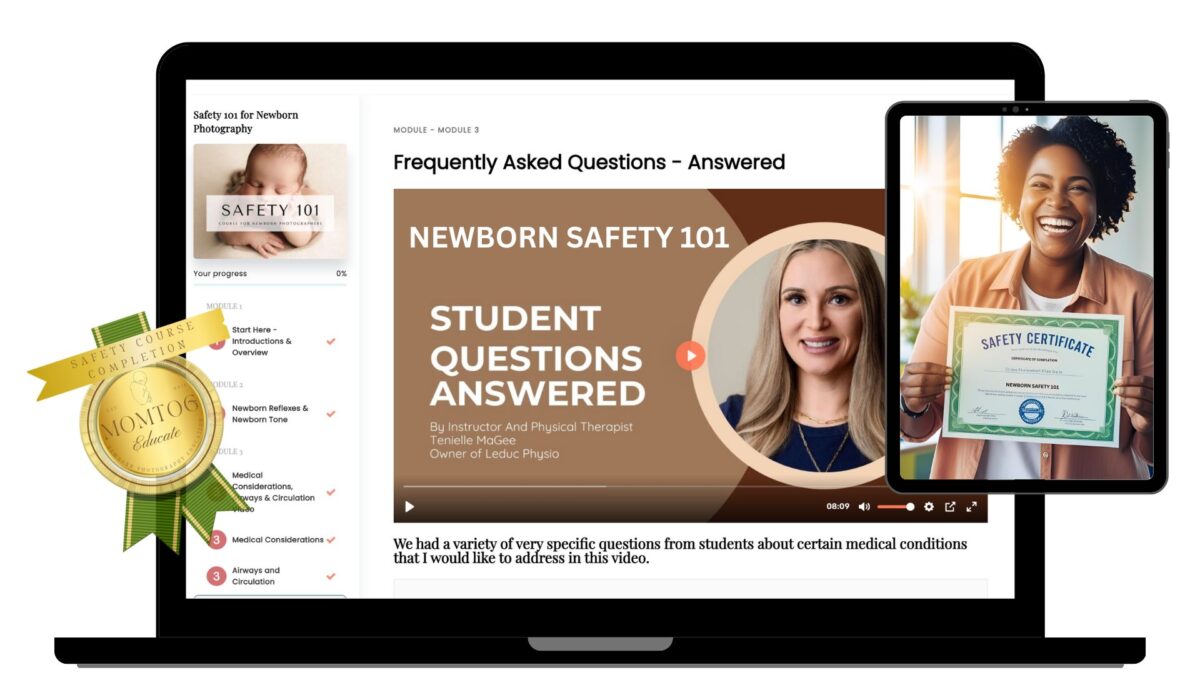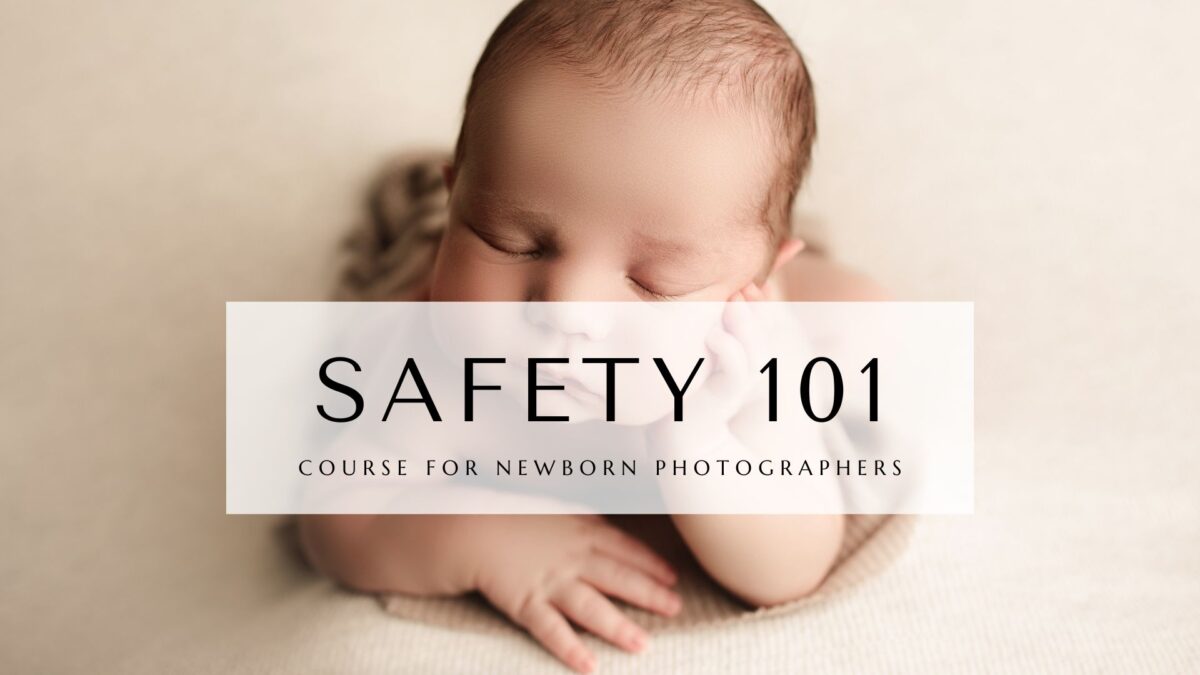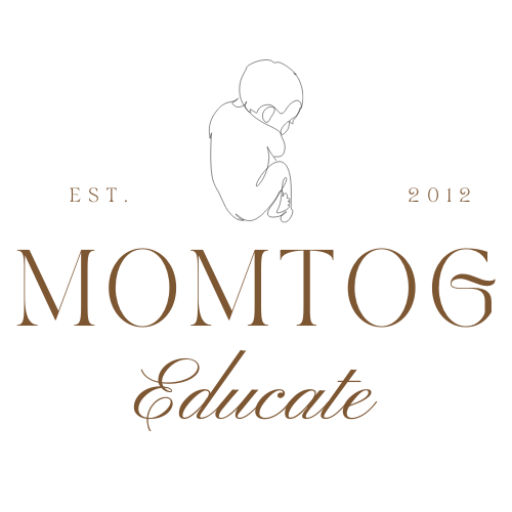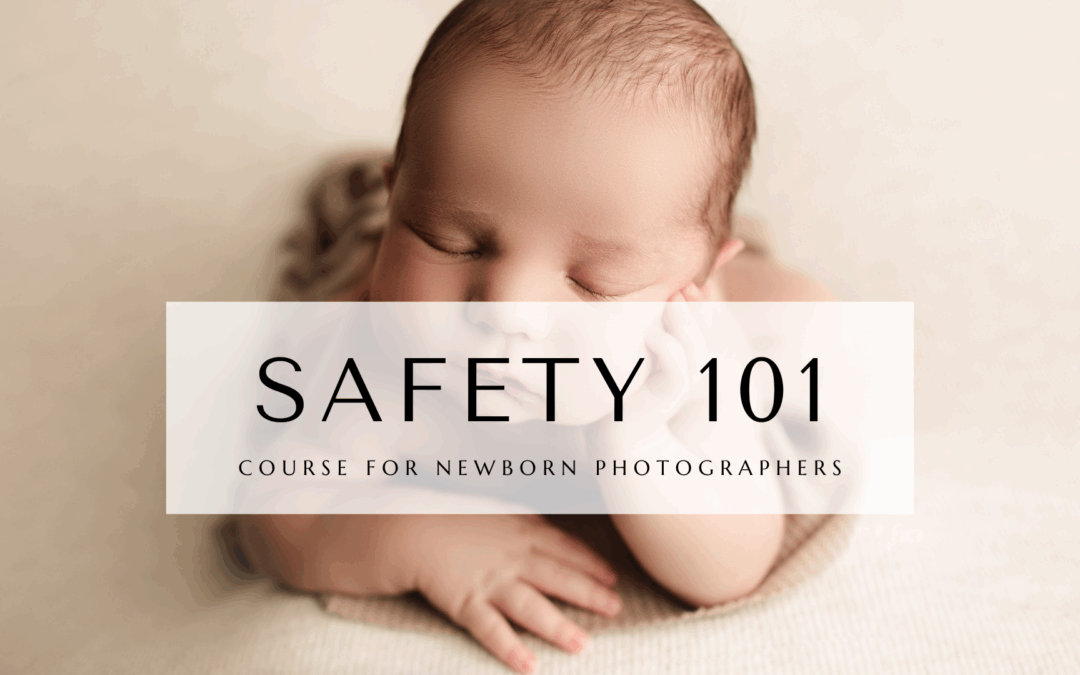When it comes to newborn photography, there is nothing more important than the safety and wellbeing of the baby in front of your camera.
In Edmonton, the City that I work from, parents seek photographers they can trust with their precious little ones. Yet too often, new photographers enter the field without truly understanding the depth of responsibility required to handle newborns safely and confidently. They think that it’s no big deal to have a camera and grab a baby blanket and swaddle a newborn. But there is so much more to it then that. A newborn session is MORE important then a wedding or any other high profile event. The photographer who is chosen for a newborn session is responsible for handling a HUMAN LIFE. That’s where the Newborn Photography Safety Course designed by Tenielle MaGee at Leduc Physio comes in – and why I believe every newborn photographer should consider investing in this comprehensive safety education.
This isn’t just another course on posing or lighting.
This isn’t just another course on posing or lighting. This course, offered through MomTog Educate, is built on a unique foundation: real medical expertise from Tenielle MaGee, a licensed physiotherapist with over 23 years of experience and owner of her own clinic, along with insights from Kathryn Barredo, an experienced newborn photographer. Together, they bridge the gap between creative artistry and critical safety protocols – a combination that is rarely found elsewhere.
Why Safety Training is Non-Negotiable in Newborn Photography
Babies are fragile. They have delicate bones, unsteady neck control, and unpredictable reflexes that can easily lead to unsafe situations if a photographer is unaware or unprepared. As professionals, we not only need to create beautiful images but also protect the vulnerable little humans entrusted to us. Parents often assume we know exactly how to handle babies safely; but unless you’ve invested in proper education, you could unknowingly put a baby at risk.
Beyond physical safety, there’s also the matter of protecting yourself and your business. Without clear protocols and legally sound contracts in place, photographers leave themselves open to serious liability should anything go wrong. This newborn photography safety course covers both sides of safety – caring for the newborn and protecting the photographer.

What Makes This Newborn Safety Course Different?
So what exactly sets this course apart? First, it goes beyond surface-level advice. The modules break down:
- How to handle newborns properly to avoid strain on their neck and spine.
- How to spot potential medical red flags that could affect a session.
- Detailed safe posing techniques with physiotherapy-based explanations of what a baby’s body can and cannot do.
- Essential hygiene and sanitization protocols.
- Ergonomic practices to keep YOU healthy and injury-free during sessions.
- The business side of safety: contracts, liability waivers, and communication strategies with parents.
The course is delivered in digestible modules with video demonstrations and step-by-step guidance. It is designed to help you build a solid foundation of safety knowledge that you can implement immediately in your sessions.
Let’s Talk About Certificate of Completion vs. Certification
One important note: while this course is thorough and expertly designed, it is not an official “certification.” There is currently no recognized certifying body in Canada or anywhere in the world for newborn photography safety. However, upon completion of this course, you will receive a Certificate of Completion. This certificate demonstrates that you have invested in safety education and have completed comprehensive training under a licensed physiotherapist specializing in newborn care. It’s an excellent credential to show potential clients that you take safety seriously. You will be given a filled out certificate of completion and a Badge for your website!
Course Modules and What You’ll Learn
Let’s take a closer look at what you’ll find in the course:
- The Anatomy of a Newborn: Understand the physiological needs and vulnerabilities of newborns. This includes medical considerations that you may have never heard of or ever worked with. If you know exactly what to do in a newborn session with a broken collar bone or perhaps high muscle tone, you can feel calm and remain professional giving your clients the best experience possible.
- Safe Handling Techniques: Learn how to lift, position, and transition babies safely between poses.
- Posing Safety Fundamentals: Master tried-and-true posing strategies that minimize strain on the baby.
- Medical Red Flags: Identify conditions and signs that should signal stopping or modifying a session.
- Ergonomics & Photographer Safety: Protect your own body with smart studio setup and posture practices.
- Hygiene & Environment Protocols: From sanitizing props to maintaining safe room temperatures.
- Contracts & Communication: Set clear expectations with parents and protect your business with robust legal agreements.
Why All Newborn Photographers Should Take This Course
In the competitive newborn photography market, your reputation is everything. Parents talk – and they want to feel confident they are choosing a photographer who puts safety first. Completing this course (and sharing that you’ve done) sets you apart. It tells clients you have gone the extra mile to protect their baby and provide a professional, thoughtful experience.
Additionally, Tenielle MaGee’s expertise is rooted in Alberta Canada’s regulatory environment and medical standards that is of the highest standards, giving photographers an added layer of confidence that what they learn is relevant and credible.
Building Client Trust Through Safety
I can’t count how many times a photographer has asked in an online thread “How do you know the baby is safe in that pose?” Don’t be that photographer. Education is everything. Understand beforehand what is safe and what to avoid will give you confidence to answer with evidence-based practices, rooted in physiotherapy training, and that is powerful. Clients are more likely to trust you, refer you, and return for future sessions.
Your Business, Your Body, Your Legacy
Safety isn’t just about the baby. This course also helps protect you. Many photographers struggle with chronic back, neck, and shoulder pain from repetitive movements and awkward positions during shoots. Tenielle MaGee addresses how to set up your space and manage sessions so you can sustain your career for years to come without injuring yourself.
Beyond that, your business liability is also safer when you operate with clear contracts, protocols, and a firm understanding of risk management.

How to Enroll and What to Expect
You can sign up for the Newborn Photography Safety Course at MomTog Educate’s website. Once enrolled, you’ll gain access to the video modules, downloadable resources, and practical exercises. There is a final quiz and checklists along the way to help you absorb the material fully. At the end, you’ll receive a Certificate of Completion that you can share with clients and add to your website or marketing materials.
Final Thoughts: Invest in Safety, Invest in Your Future
There is no image worth risking a baby’s wellbeing. Parents trust us with the most precious beings in their lives. If you want to elevate your artistry while building a sustainable, trustworthy business, safety training is non-negotiable.
This course is unlike anything else on the market – designed with both medical insight and real-world photography experience. If you’re serious about your craft, and serious about caring for the babies you photograph, consider taking this step. Your clients, your body, and your future self will thank you.


